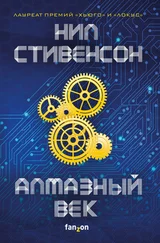Нил Стивенсон - Diamond Age
Здесь есть возможность читать онлайн «Нил Стивенсон - Diamond Age» весь текст электронной книги совершенно бесплатно (целиком полную версию без сокращений). В некоторых случаях можно слушать аудио, скачать через торрент в формате fb2 и присутствует краткое содержание. Жанр: Киберпанк, на английском языке. Описание произведения, (предисловие) а так же отзывы посетителей доступны на портале библиотеки ЛибКат.
- Название:Diamond Age
- Автор:
- Жанр:
- Год:неизвестен
- ISBN:нет данных
- Рейтинг книги:3 / 5. Голосов: 1
-
Избранное:Добавить в избранное
- Отзывы:
-
Ваша оценка:
- 60
- 1
- 2
- 3
- 4
- 5
Diamond Age: краткое содержание, описание и аннотация
Предлагаем к чтению аннотацию, описание, краткое содержание или предисловие (зависит от того, что написал сам автор книги «Diamond Age»). Если вы не нашли необходимую информацию о книге — напишите в комментариях, мы постараемся отыскать её.
Diamond Age — читать онлайн бесплатно полную книгу (весь текст) целиком
Ниже представлен текст книги, разбитый по страницам. Система сохранения места последней прочитанной страницы, позволяет с удобством читать онлайн бесплатно книгу «Diamond Age», без необходимости каждый раз заново искать на чём Вы остановились. Поставьте закладку, и сможете в любой момент перейти на страницу, на которой закончили чтение.
Интервал:
Закладка:
The children in the center had their backs to Hackworth and were mostly seen in silhouette, looking directly up and raising their arms toward the light. The kids in bottom right balanced the angelic host on the bottom left; these were the spirits of unborn children yet to benefit from the Engineer's work, though they certainly looked eager to get born as soon as possible. Their backdrop was a luminescent, undulous curtain, much like the aurora, which was actually a continuation of the flowing skirts of Victoria II seated on her throne above.
"Pardon me, Mr. Cotton," Hackworth said, almost sotto voce. He had worked here once, for several years, and knew the etiquette. A hundred designers were sitting in the hall, neatly arranged in rows. All had their heads wrapped up in phenomenoscopes. The only persons who were aware of Hackworth's presence in the hall were Supervising Engineer Dung, his lieutenants Chu, DeGrado, and Beyerley, and a few water-boys and couriers standing erect at their stations around the perimeter. It was bad form to startle the engineers, so you approached them loudly and spoke to them softly.
"Good morning, Mr. Hackworth," Cotton said.
"Good morning, Demetrius. Take your time."
"I'll be with you in a moment, sir."
Cotton was a southpaw. His left hand was in a black glove. Laced through it was a network of invisibly tiny rigid structures, motors, position sensors, and tactile stimulators. The sensors kept track of his hand's position, how much each joint of each knuckle was bent, and so on. The rest of the gear made him feel as though he were touching real objects.
The glove's movements were limited to a roughly hemispherical domain with a radius of about one cubit; as long as his elbow stayed on or near its comfy elastomeric rest, his hand was free. The glove was attached to a web of infinitesimal wires that emerged from filatories placed here and there around the workstation. The filatories acted like motorized reels, taking up slack and occasionally pulling the glove one way or another to simulate external forces. In fact they were not motors but little wire factories that generated wire when it was needed and, when slack needed to be taken up or a wire needed a tug, sucked it back in and digested it. Each wire was surrounded by a loose accordion sleeve a couple of millimeters in diameter, which was there for safety, lest visitors stick their hands in and slice off fingers on the invisible wires.
Cotton was working with some kind of elaborate structure consisting, probably, of several hundred thousand atoms. Hackworth could see this because each workstation had a mediation providing a two-dimensional view of what the user was seeing. This made it easy for the supervisors to roam up and down the aisles and see at a glance what each employee was up to.
The structures these people worked with seemed painfully bulky to Hackworth, even though he'd done it himself for a few years. The people here in Merkle Hall were all working on mass-market consumer products, which by and large were not very demanding. They worked in symbiosis with big software that handled repetitive aspects of the job. It was a fast way to design products, which was essential when going after the fickle and impressionable consumer market. But systems designed that way always ended up being enormous. An automated design system could always make something work by throwing more atoms at it. Every engineer in this hall, designing those nanotechnological toasters and hair dryers, wished he could have Hackworth's job in Bespoke, where concinnity was an end in itself, where no atom was wasted and every subsystem was designed specifically for the task at hand. Such work demanded intuition and creativity, qualities neither abundant nor encouraged here in Merkle Hall. But from time to time, over golf or karaoke or cigars, Dung or one of the other supervisors would mention some youngster who showed promise. Because Lord Alexander Chung-Sik Finkle-McGraw was paying for Hackworth's current project, the Young Lady's Illustrated Prime r, price was no object. The Duke would brook no malingering or corner-cutting, so everything was as start as Bespoke could make it, every atom could be justified.
Even so, there was nothing especially interesting about the power supply being created for the Primer, which consisted of batteries of the same kind used to run everything from toys to airships. So Hackworth had farmed that part of the job out to Cotton, just to see whether he had potential.
Cotton's gloved hand fluttered and probed like a stuck horsefly in the center of the black web. On the mediatronic screen attached to his workstation, Hackworth saw that Cotton was gripping a medium-size (by Merkie Hall standards) subassembly, presumably belonging to some much larger nanotechnological system. The standard color scheme used in these phenomenoscopes depicted carbon atoms in green, sulfur in yellow, oxygen in red, and hydrogen in blue. Cotton's assembly, as seen from a distance, was generally turquoise because it consisted mostly of carbon and hydrogen, and because Hackworth's point of view was so far away that the thousands of individual atoms all blended together. It was a gridwork of long, straight, but rather bumpy rods laid across each other at right angles. Hackworth recognized it as a rod logic system— a mechanical computer.
Cotton was trying to snap it together with some larger part. From this Hackworth inferred that the auto-assembly process (which Cotton would have tried first) hadn't worked quite right, and so now Cotton was trying to maneuver the part into place by hand. This wouldn't fix what was wrong with it, but the telæsthetic feedback coming into his hand through those wires would give him insight as to which bumps were lining up with which holes and which weren't. It was an intuitive approach to the job, a practice furiously proscribed by the lecturers at the Royal Nanotechnological Institute but popular among Hackworth's naughty, clever colleagues.
"Okay," Cotton finally said, "I see the problem." His hand relaxed. On the mediatron, the subassembly drifted away from the main group under its own momentum, then slowed, stopped, and began to fall back toward it, drawn in by weak van den Waals forces. Cotton's right hand was resting on a small chordboard; he whacked a key that froze the simulation, then, as Hackworth noted approvingly, groped the keys for a few seconds, typing in some documentation. Meanwhile he was withdrawing his left hand from the glove and using it to pull the rig off his head; its straps and pads left neat indentations in the nap of his hair.
"Is this the smart makeup?" Hackworth said, nodding at the screen.
"The next step beyond," Cotton said. "Remote-control."
"Controlled how? Yuvree?" Hackworth said, meaning Universal Voice Recognition Interface.
"A specialised variant thereof, yes sir," Cotton said. Then, lowering his voice, "Word has it they considered makeup with nanoreceptors for galvanic skin response, pulse, respiration, and so on, so that it would respond to the wearer's emotional state. This superficial, need I say it, cosmetic issue concealed an undertow that pulled them out into deep and turbulent philosophical waters-"
"What? Philosophy of makeup?"
"Think about it, Mr. Hackworth— is the function of makeup to respond to one's emotions— or precisely not to do so?"
"These waters are already over my head," Hackworth admitted.
"You'll be wanting to know about the power supply for Runcible," Cotton said, using the code name for the Illustrated Primer. Cotton had no idea what Runcible was, just that it needed a relatively long-lived power supply.
"Yes."
"The modifications you requested are complete. I ran the tests you specified plus a few others that occurred to me— all of them are documented here." Cotton grabbed the heavy brasslike pull of his desk drawer and paused for a fraction of a second while the embedded fingerprint-recognition logic did its work. The drawer unlocked itself, and Cotton pulled it open to reveal a timeless assortment of office drawer miscellany, including several sheets of paper— some blank, some printed, some scrawled on, and one sheet that was blank except for the word RUNCIBLE printed at the top in Cotton's neat draughtsman's hand. Cotton pulled this one out and spoke to it: "Demetrius James Cotton transferring all privileges to Mr. Hackworth."
Читать дальшеИнтервал:
Закладка:
Похожие книги на «Diamond Age»
Представляем Вашему вниманию похожие книги на «Diamond Age» списком для выбора. Мы отобрали схожую по названию и смыслу литературу в надежде предоставить читателям больше вариантов отыскать новые, интересные, ещё непрочитанные произведения.
Обсуждение, отзывы о книге «Diamond Age» и просто собственные мнения читателей. Оставьте ваши комментарии, напишите, что Вы думаете о произведении, его смысле или главных героях. Укажите что конкретно понравилось, а что нет, и почему Вы так считаете.
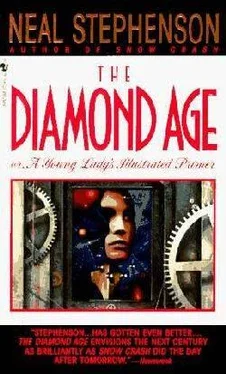
![Нил Стивенсон - Криптономикон [litres]](/books/23868/nil-stivenson-kriptonomikon-litres-thumb.webp)

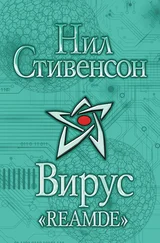
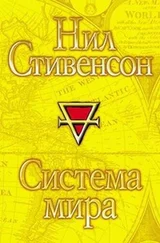



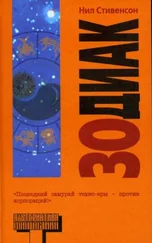
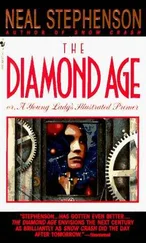
![Нил Стивенсон - Лавина [litres с оптимизированной обложкой]](/books/414066/nil-stivenson-lavina-litres-s-optimizirovannoj-ob-thumb.webp)
